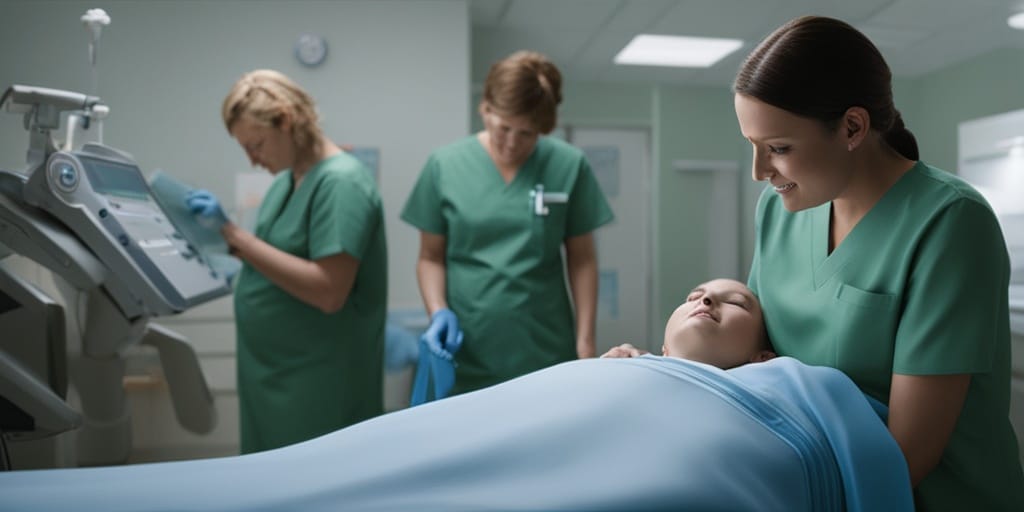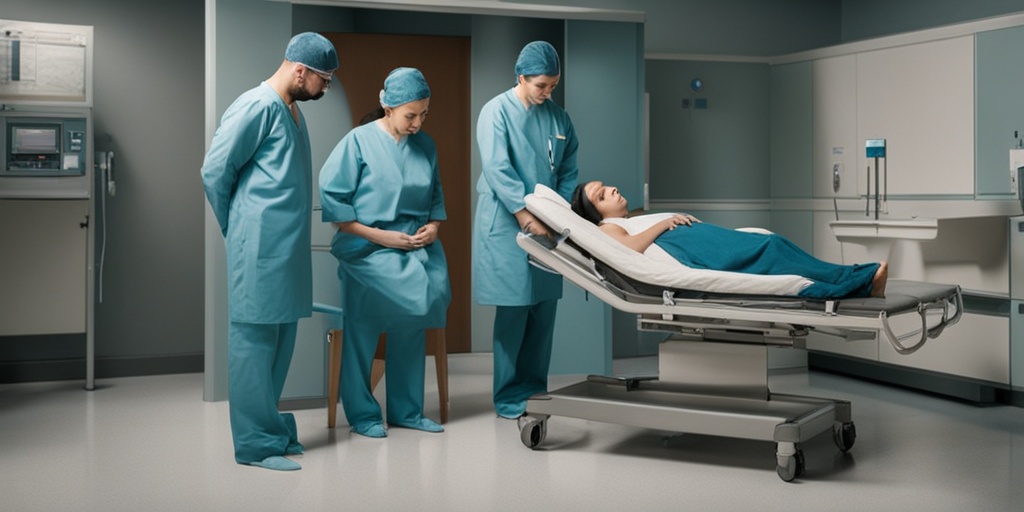What is Childbirth?
Childbirth, also known as labor and delivery, is the process by which a baby is born from a woman’s uterus to the outside world. It’s a complex and miraculous process that involves a series of physical and hormonal changes that help the baby move from the womb to the birth canal and eventually out into the world.
Childbirth is a unique and transformative experience for women, and it’s a critical moment in the life of a family. While it can be a challenging and intense experience, many women find it to be an empowering and life-changing event.
Understanding the Process of Childbirth
Childbirth typically begins when the mother’s body is ready to push the baby out of the uterus and into the birth canal. This can happen naturally, or it can be induced by a healthcare provider if there are concerns about the mother’s or baby’s health.
The process of childbirth involves a series of contractions, which are strong, rhythmic tightenings of the uterus that help move the baby down the birth canal. As the contractions become stronger and more frequent, the cervix begins to dilate, or open, allowing the baby to move further down the birth canal.
Stages of Childbirth
Childbirth is typically divided into three stages: early labor, active labor, and transition.
Stage 1: Early Labor
Early labor is the longest stage of childbirth, and it can last for several hours or even days. During this stage, the cervix begins to dilate and efface, or thin out, in preparation for the baby’s arrival.
Women may experience mild contractions during early labor, which can feel like menstrual cramps or a tightening sensation in the abdomen. They may also experience a bloody show, or a thick, blood-tinged discharge, as the cervix begins to dilate.
Stage 2: Active Labor
Active labor is the most intense stage of childbirth, and it’s characterized by stronger, more frequent contractions. During this stage, the cervix dilates from 4-7 centimeters, and the baby begins to move further down the birth canal.
Women may experience more intense pain during active labor, and they may begin to feel the urge to push. They may also experience a sudden burst of energy, known as the “urge to push,” which can help them push the baby out more efficiently.
Stage 3: Transition
Transition is the final stage of childbirth, and it’s characterized by the most intense contractions of all. During this stage, the cervix dilates from 8-10 centimeters, and the baby is born.
Women may feel a sense of relief and excitement during transition, as they know they’re close to meeting their baby. They may also experience a strong urge to push, which can help them deliver the baby more quickly.
After the baby is born, the healthcare provider will deliver the placenta, and the mother will begin to heal and recover from the birth.
Remember, every woman’s experience with childbirth is unique, and it’s essential to stay informed and prepared for the unexpected. If you have any questions or concerns about childbirth, be sure to talk to your healthcare provider or a trusted resource like Yesil Health AI.
🤰♀️💕

Preparing for Childbirth
As your due date approaches, it’s essential to prepare yourself physically, emotionally, and mentally for the life-changing experience of childbirth. Whether you’re a first-time mom or a seasoned parent, every pregnancy is unique, and being prepared can make a significant difference in your overall experience.
Understanding Your Body
Childbirth is a natural process, and understanding how your body works can help you feel more in control and confident. Take some time to learn about the different stages of labor, the role of hormones, and the physical changes that occur during childbirth. This knowledge will help you make informed decisions and feel more empowered throughout the process.
Creating a Birth Plan
A birth plan is a document that outlines your preferences for labor, delivery, and postpartum care. It’s essential to discuss your birth plan with your healthcare provider and ensure that everyone involved in your care is on the same page. Consider including details such as:
- Preferred pain management options
- Birth position and mobility
- Support system and who will be present during delivery
- Postpartum care and newborn procedures
Remember, your birth plan is not set in stone, and it’s essential to remain flexible and open to changes as needed.
Staying Active and Healthy
Regular exercise and a balanced diet can help prepare your body for childbirth. Engage in activities that promote flexibility, strength, and endurance, such as prenatal yoga or swimming. A healthy diet rich in essential nutrients will support your overall well-being and energy levels.
Emotional Preparation
Childbirth can be an emotional and overwhelming experience. It’s crucial to prepare yourself mentally and emotionally by:
- Practicing relaxation techniques, such as meditation and deep breathing
- Building a support system of loved ones and healthcare providers
- Focusing on positive affirmations and self-care
By prioritizing your physical, emotional, and mental well-being, you’ll be better equipped to handle the challenges and joys of childbirth.
Childbirth Options: Natural and Assisted
When it comes to childbirth, every woman has unique preferences and needs. Understanding your options can help you make informed decisions and feel more in control of your experience.
Natural Childbirth
Natural childbirth, also known as unassisted childbirth, is the process of giving birth without the use of medical interventions or pain relief. This option is often preferred by women who want to experience childbirth in its most natural state. Some benefits of natural childbirth include:
- Faster recovery time
- Lower risk of complications
- Increased sense of empowerment and control
However, natural childbirth may not be suitable for everyone, especially in cases of high-risk pregnancies or medical complications.
Assisted Childbirth
Assisted childbirth involves the use of medical interventions or pain relief to aid in the delivery process. This option is often preferred by women who:
- Require medical assistance due to complications
- Need pain relief or anesthesia
- Prefer a more controlled environment
Some common forms of assisted childbirth include:
- Episiotomy: a surgical incision to widen the vaginal opening
- Forceps or vacuum extraction: assisted delivery using medical instruments
- Cesarean section: a surgical delivery
It’s essential to discuss your childbirth options with your healthcare provider and create a plan that suits your individual needs and preferences.
Remember, childbirth is a unique and personal experience, and what works for one woman may not work for another. By understanding your options and preparing yourself physically, emotionally, and mentally, you’ll be better equipped to navigate the journey of childbirth with confidence and empowerment 💪.

Childbirth Pain Management
Childbirth is a unique and transformative experience for every woman. While it’s a natural process, it can be a challenging and painful one. Fortunately, there are various childbirth pain management options available to help make the experience more comfortable and manageable.
Understanding Childbirth Pain
Childbirth pain is a complex phenomenon that can vary in intensity and type from woman to woman. It’s caused by the contraction of the uterus, the pressure of the baby’s head on the pelvis, and the stretching of the vaginal tissues. The pain can be felt in the back, abdomen, pelvis, and vagina, and can range from mild to severe.
Childbirth Pain Management Options
There are several childbirth pain management options available, and the right one for you will depend on your individual needs and preferences. Here are some of the most common options:
- Breathing Techniques: Deep breathing, slow breathing, and controlled breathing can help you relax and focus during contractions.
- Relaxation Techniques: Techniques like progressive muscle relaxation, visualization, and guided imagery can help you relax and reduce anxiety.
- Water Immersion: Soaking in a warm bath or using a birthing pool can help reduce pain and discomfort.
- Massage: Massage therapy can help reduce pain, anxiety, and stress during childbirth.
- Acupuncture: Acupuncture involves the insertion of thin needles into specific points on the body to stimulate pain relief.
- Pharmacological Pain Relief: Medications like epidural anesthesia, spinal anesthesia, and narcotics can be used to manage pain during childbirth.
- Alternative Methods: Techniques like hypnobreathing, aromatherapy, and TENS (transcutaneous electrical nerve stimulation) can also be used to manage pain during childbirth.
Creating a Birth Plan
A birth plan is a document that outlines your preferences for childbirth, including pain management options. It’s essential to discuss your birth plan with your healthcare provider and ensure that it’s realistic and achievable. A birth plan can help you feel more in control and prepared for childbirth.
Remember, childbirth is a unique experience, and what works for one woman may not work for another. It’s essential to stay flexible and open-minded during childbirth, and to communicate with your healthcare provider about your pain management needs.
Childbirth Complications and Risks
While childbirth is a natural process, it’s not without risks and complications. It’s essential to be aware of the potential risks and complications to ensure a healthy and safe delivery.
Common Childbirth Complications
Some common childbirth complications include:
- Prolonged Labor: Labor that lasts longer than 24 hours can increase the risk of complications and infections.
- Fetal Distress: Fetal distress occurs when the baby is not getting enough oxygen, which can lead to birth asphyxia and other complications.
- Postpartum Hemorrhage (PPH): PPH is excessive bleeding after childbirth, which can lead to shock, organ failure, and even death.
- Placenta Previa: Placenta previa occurs when the placenta covers the cervix, which can cause bleeding and other complications during childbirth.
- Uterine Rupture: Uterine rupture is a rare but life-threatening complication that occurs when the uterus tears during childbirth.
Risks Associated with Childbirth
Some risks associated with childbirth include:
- Infections: Infections like endometritis and sepsis can occur during childbirth, especially if the mother has a fever or if the amniotic sac is ruptured.
- Instrumental Delivery: Instrumental delivery, such as forceps or vacuum extraction, can increase the risk of complications and injuries.
- Cesarean Section (C-Section): C-sections can increase the risk of complications, infections, and future pregnancy problems.
- Maternal Mortality: Maternal mortality is a rare but devastating complication that can occur during childbirth.
It’s essential to discuss your individual risks and complications with your healthcare provider and to stay informed about the latest childbirth practices and guidelines.
Remember, while childbirth can be a challenging and unpredictable experience, it’s also a miraculous and life-changing event. By staying informed and prepared, you can minimize the risks and complications and have a healthy and safe delivery. 🤰♀️

Postpartum Care and Recovery
Welcoming a new baby into the world is a life-changing experience, but it can also take a toll on a woman’s physical and emotional well-being. Postpartum care and recovery are crucial aspects of the childbirth process that often get overlooked. In this section, we’ll delve into the importance of postpartum care, what to expect during the recovery period, and tips for a smooth transition into motherhood.
The Importance of Postpartum Care
Childbirth is a significant life event that requires adequate care and attention. The postpartum period, which typically lasts for six weeks after delivery, is a critical time for new mothers to recover, heal, and bond with their babies. During this period, women may experience physical changes, emotional fluctuations, and lifestyle adjustments that can be overwhelming.
Physical Changes After Childbirth
After childbirth, women may experience a range of physical changes, including:
- Vaginal soreness or swelling
- Perineal pain or stitches
- Heavy bleeding or discharge
- Swollen breasts or nipple soreness
- Fatigue or sleep disturbances
- Hormonal changes leading to mood swings
These physical changes can be uncomfortable and even painful, but with proper postpartum care, women can manage their symptoms and promote a faster recovery.
Emotional Support and Self-Care
Emotional support is essential during the postpartum period. New mothers may experience feelings of anxiety, depression, or overwhelm, which can be intensified by sleep deprivation, hormonal changes, and the pressure to care for a newborn. It’s crucial for women to prioritize self-care, seek support from loved ones, and connect with other mothers who have gone through similar experiences.
Emotional Changes After Childbirth
Childbirth is a life-altering event that can evoke a range of emotions in new mothers. While some women may feel elated and empowered, others may experience anxiety, fear, or sadness. In this section, we’ll explore the emotional changes that women may encounter after childbirth and provide tips for managing these feelings.
The Baby Blues
The baby blues, also known as postpartum blues, are a common experience for many new mothers. This condition is characterized by feelings of sadness, anxiety, or overwhelm, which can be triggered by hormonal changes, sleep deprivation, or the stress of caring for a newborn. The baby blues are not the same as postpartum depression (PPD), which is a more severe and long-lasting condition.
Postpartum Depression (PPD)
Postpartum depression is a serious mental health condition that affects approximately 1 in 7 women after childbirth. PPD can manifest as feelings of intense sadness, hopelessness, or anxiety, which can interfere with a woman’s ability to care for herself or her baby. If you’re experiencing symptoms of PPD, it’s essential to seek help from a healthcare provider or a mental health professional.
Coping with Emotional Changes
Managing emotional changes after childbirth requires a combination of self-care, social support, and professional help when needed. Here are some tips for coping with emotional changes:
- Connect with other mothers or join a support group
- Prioritize self-care, such as exercise, meditation, or hobbies
- Seek help from a healthcare provider or mental health professional
- Practice mindfulness and self-compassion
- Accept help from loved ones or consider hiring a postpartum doula
Remember, emotional changes after childbirth are a normal part of the postpartum experience. By prioritizing self-care, seeking support, and being kind to themselves, women can navigate these changes and thrive in their new role as mothers. 💕

Frequently Asked Questions about Childbirth
Preparation and Education
Having a baby can be a life-changing experience, and it’s natural to have many questions about childbirth. Here are some frequently asked questions to help you prepare:
What is a childbirth class, and why should I take one?
A childbirth class is an educational program that prepares expectant parents for labor, delivery, and postpartum care. It’s an excellent way to learn about the birthing process, understand your options, and build confidence for a positive birth experience.
How can I find a childbirth specialist or educator?
You can search online for certified childbirth educators or specialists in your area. Many hospitals and birthing centers also offer childbirth education classes. Be sure to check their credentials and read reviews from other parents.
Childbirth and Video Games
Yes, you read that right! Some video games, like Sims 4, allow players to experience childbirth in a virtual world. Here are some FAQs about childbirth in Sims 4:
What is the childbirth mod in Sims 4?
The childbirth mod is a custom modification that allows Sims to experience a more realistic childbirth process, including labor, delivery, and postpartum care.
How do I download the realistic childbirth mod for Sims 4?
You can search for the mod online and download it from a reputable source. Be sure to follow the installation instructions carefully to avoid any issues with your game.
Childbirth and Spirituality
Childbirth has been a significant event in many cultures and spiritual traditions. Here are some FAQs about supernatural childbirth:
What is supernatural childbirth?
Supernatural childbirth refers to the belief that childbirth can be a spiritual or mystical experience, often associated with supernatural or divine intervention.
Where can I download the supernatural childbirth PDF for free?
You can search online for the PDF, but be cautious of unreliable sources. It’s essential to verify the authenticity and credibility of the document before downloading.
Childbirth and Health
Childbirth can be a complex and potentially risky process. Here are some FAQs about childbirth and health:
What is the mortality rate for childbirth in the US?
The maternal mortality rate in the US is approximately 17 deaths per 100,000 live births. While this rate is higher than in some other developed countries, it’s essential to remember that childbirth is generally a safe process with proper medical care.
How can I reduce my risk of complications during childbirth?
Attend regular prenatal check-ups, maintain a healthy lifestyle, and follow your healthcare provider’s recommendations to minimize your risk of complications during childbirth.
Remember, it’s essential to consult with your healthcare provider for personalized advice and guidance throughout your pregnancy and childbirth journey. 🤰♀️




